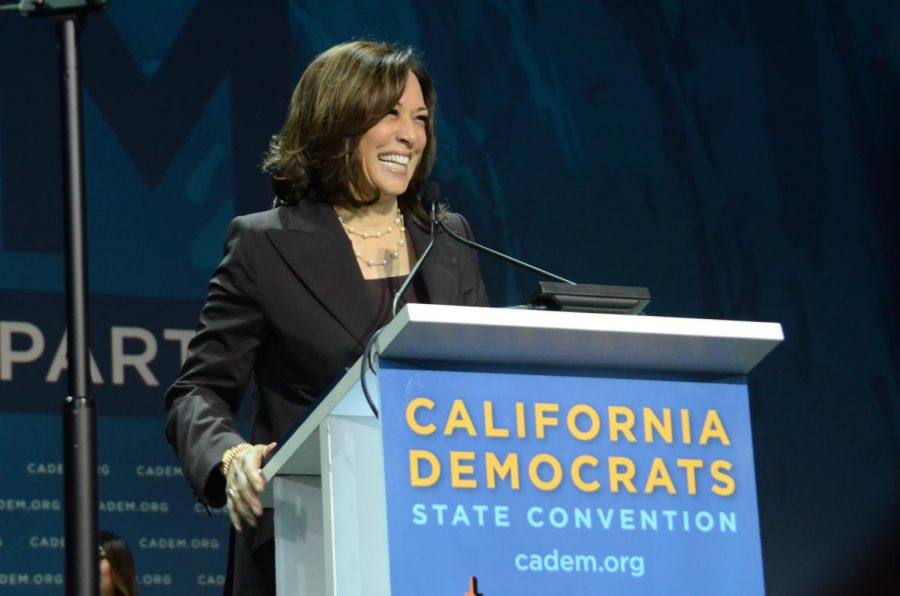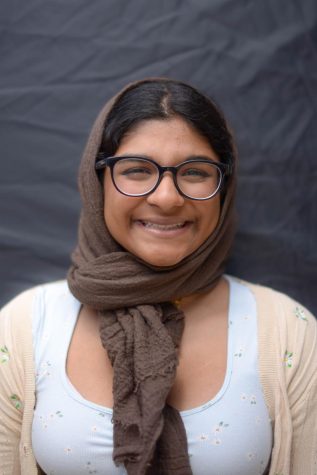Kamala Harris “has changed the landscape”: Nomination paves way for women of color in politics
U.S. Senator Kamala Harris speaks at a General Assembly during the California Democrats 2019 State Convention on Saturday morning. There have been only two female major party vice presidential nominees in U.S. history; Sen. Kamala Harris (D-C.A.) is the third.
September 9, 2020
According to the United States Census Bureau, women make up 50.8 percent of the country’s population, Black people make up 13.4 percent and Asian people make up 5.9 percent.
In addition to only one female major party presidential nominee, there have been only two female major party vice presidential nominees in U.S. history. Sen. Kamala Harris (D-C.A.) is the third.
Democratic presidential nominee Joe Biden’s selection of Harris as his running mate for the 2020 election signifies the first time a Black and South Asian-American woman has had her name on a major party ticket.
Harris was born in Oakland to Shyamala Gopalan and Donald Harris, both of whom immigrated to California from India and Jamaica, respectively, to pursue graduate degrees at the University of California, Berkeley.
In her speech at the Democratic National Convention last month, Harris talked in great detail about the tremendous influence Gopalan had on her and her sister. She said, “[My mother] raised us to be proud, strong Black women. And she raised us to know and be proud of our Indian heritage.”
Other Black and South Asian women unite in a medley of pride and comfort in having Harris’s name on the ticket as they are ready for her to become the start of national representation in politics for women of color.
“She’s a force to be reckoned with. With Harris having those two sides [of her race], it adds more to the table,” said Youth Activism club secretary Uma Iyer (11), who identifies as Indian American. “It’s so important to have Black and brown people represented in the government, and having [her] is a really good step.”
While Harris identifies as a Black woman, she, like many other biracial people, has found ways to converge her two backgrounds while growing up in a country still grappling with desegregation. She visited her mother’s family in Madras, India, often during her childhood and later chose to attend Howard University, a historically Black university where she entered into a distinguished Black sorority, Alpha Kappa Alpha.
Biden’s announcement in March that his vice presidential pick would be a woman immediately generated a flurry of conversation as lobbying groups and organizations like Sisters Lead Sisters Vote pressured him to choose a Black woman. Harris’s status as a mixed-race daughter of immigrants and the significance of her interracial marriage are a testament to the country’s rapidly changing ethnic and cultural fabrics as American cities attract more and more foreign-born populations along with the nationwide reckoning with racial violence and discrimination this past summer.
Protima Pandey, director of the Office of Women’s Policy for Santa Clara County and a managing attorney who identifies as Indian, spoke about the struggles she faced while working as an attorney in a workplace dominated by older, white men.
“There are few women of color who are also lawyers, [which] motivated me to work harder. The court clerk remembered everyone by their first name, but they had trouble remembering a name like Protima,” she said. “In the last three months, the sense of urgency for this importance of diversity has increased.”
Brian Pinkston (12), who identifies as Black, is a youth activist and is working with the Harker administration to foster diversity and inclusion as part of the Student Diversity Coalition.
“We need to create more support groups for people of color and right now we’re having the Latinx and Black student unions established as separate affinity groups [at Harker],” he said. “I would say [as advice for youth of color wanting to pursue activism] find a group to get your message out there.”
In addition to feeling hopeful that the nomination could act as a means of establishing more representation for Black and South Asian groups, these women look to future generations who can lean on Harris’s leadership and trailblazing legacy.
Patricia Burrows, the dean of the middle school and a member of the Diversity Committee, identifies as Taiwanese-American and connects strongly with Kamala Harris’ story of being a child of immigrants.
“I have people asking me where I’m from because the sound of my voice doesn’t seem to jar well with the picture that my face represents,” she said. “I find it remarkable that my daughter is growing up in a time where she has so many different kinds of leaders to choose from, and having someone in a position of power who understands these ideas of an immigrant and an immigrant family is really comforting.”
Pandey looks at the nomination as having “changed the landscape” of the national stage. She acknowledged that a job in public service clashes with the goal of securing a well-paying job that many immigrant parents have for their children but emphasized the role of young people in changing that stereotype.
“We have to start to remember that living in this country, students like you are not an outsider. You are part of the fabric of this country and being part of this means giving back to the community to make our voices heard,” she said. “Think about why we need to be in those spaces so that our representation needs to get counted.”


















![“[Building nerf blasters] became this outlet of creativity for me that hasn't been matched by anything else. The process [of] making a build complete to your desire is such a painstakingly difficult process, but I've had to learn from [the skills needed from] soldering to proper painting. There's so many different options for everything, if you think about it, it exists. The best part is [that] if it doesn't exist, you can build it yourself," Ishaan Parate said.](https://harkeraquila.com/wp-content/uploads/2022/08/DSC_8149-900x604.jpg)




![“When I came into high school, I was ready to be a follower. But DECA was a game changer for me. It helped me overcome my fear of public speaking, and it's played such a major role in who I've become today. To be able to successfully lead a chapter of 150 students, an officer team and be one of the upperclassmen I once really admired is something I'm [really] proud of,” Anvitha Tummala ('21) said.](https://harkeraquila.com/wp-content/uploads/2021/07/Screen-Shot-2021-07-25-at-9.50.05-AM-900x594.png)







![“I think getting up in the morning and having a sense of purpose [is exciting]. I think without a certain amount of drive, life is kind of obsolete and mundane, and I think having that every single day is what makes each day unique and kind of makes life exciting,” Neymika Jain (12) said.](https://harkeraquila.com/wp-content/uploads/2017/06/Screen-Shot-2017-06-03-at-4.54.16-PM.png)








![“My slogan is ‘slow feet, don’t eat, and I’m hungry.’ You need to run fast to get where you are–you aren't going to get those championships if you aren't fast,” Angel Cervantes (12) said. “I want to do well in school on my tests and in track and win championships for my team. I live by that, [and] I can do that anywhere: in the classroom or on the field.”](https://harkeraquila.com/wp-content/uploads/2018/06/DSC5146-900x601.jpg)
![“[Volleyball has] taught me how to fall correctly, and another thing it taught is that you don’t have to be the best at something to be good at it. If you just hit the ball in a smart way, then it still scores points and you’re good at it. You could be a background player and still make a much bigger impact on the team than you would think,” Anya Gert (’20) said.](https://harkeraquila.com/wp-content/uploads/2020/06/AnnaGert_JinTuan_HoHPhotoEdited-600x900.jpeg)

![“I'm not nearly there yet, but [my confidence has] definitely been getting better since I was pretty shy and timid coming into Harker my freshman year. I know that there's a lot of people that are really confident in what they do, and I really admire them. Everyone's so driven and that has really pushed me to kind of try to find my own place in high school and be more confident,” Alyssa Huang (’20) said.](https://harkeraquila.com/wp-content/uploads/2020/06/AlyssaHuang_EmilyChen_HoHPhoto-900x749.jpeg)












